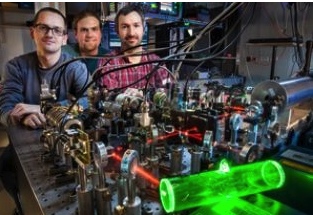Atomic Memory by Faculty of Physics at University of Warsaw
For quantum information technology
This is a Press Release edited by StorageNewsletter.com on December 9, 2014 at 3:09 pmNeither quantum computers nor quantum cryptography will become prevalent technologies without memory systems able to manipulate quantum information easily and effectively. The Faculty of Physics at the University of Warsaw (FUW), Poland has recently made inroads into popularizing quantum information technologies by creating an atomic memory with outstanding parameters and an extremely simple construction.
An atomic memory (glowing green).
From left to right: Michal Dabrowski, Radek Chrapkiewicz and Wojciech Wasilewski.
(Source: FUW, R. Chrapkiewicz)
Following years of tests in physics laboratories, the first quantum technologies are slowly emerging into wider applications. One example is quantum cryptography – an encryption method providing an almost full guarantee of secure data transmission, currently being introduced by military forces and banking institutions. Processing quantum information and sending it over long distances has so far been severely limited due to a lack of adequate memories. A solution is now within reach: FUW has created a fully-functioning atomic memory with a simple, reliable construction and numerous potential applications, including in telecommunications.
“The greatest challenge in the construction of our quantum memory was the precise selection of system parameters that would allow it to save, store and read quantum information effectively. We have also found a novel way of reducing noise during detection,” says Dr. Wojciech Wasilewski, FUW.
Contemporary fiber-optic communications involve the transmission of classical information using laser light propagated inside optical fiber cables. Attenuation causes the light signal in the optical fiber cable to weaken as the distance it travels increases. When long optical fiber cables are used, laser amplifiers multiplicating photons are placed along them at intervals of approximately 100km. These turn a weak signal comprising a low number of photons into a strong signal with high numbers of photons.
However, in quantum communications it is the individual photons and their quantum states that are important. Here signal amplification of the signal does not simply mean increasing the number of photons, but rather preserving their original, undisturbed quantum states. Unfortunately, quantum information cannot be duplicated with impunity: performing any measurement of the quantum state of the photon will inevitably affect its original state. The impossibility of quantum cloning, co-discovered by the Polish physicist Prof. Wojciech ?urek, places fundamental limitations on the operations that can be conducted on quantum information.
In 2001, a team of physicists from the University of Innsbruck and Harvard University proposed the DLCZ quantum transmission protocol, making it possible to send quantum information over long distances. Under this protocol, quantum information reaching each relay point along the channel must be stored there for a sufficiently long time to ensure that attempts at transmitting it to the next node are successful, as confirmed via a normal signal. In such a protocol, therefore, a key role is played by quantum memory in which quantum information needs to be stored for a sufficiently long time.
“Until now, quantum memory required highly sophisticated laboratory equipment and complex techniques chilling the systems to extremely low temperatures approaching absolute zero. The atomic memory device we have been able to create operates at far higher temperatures, in the region of tens of degrees Celsius, which are easier to maintain,” notes Radek Chrapkiewicz, doctoral student at the faculty and co-author of the paper in the journal Optics Express.
The main element of the memory device constructed by the University of Warsaw physicists is a glass chamber 2.5cm in diameter and 10cm long, with rubidium-coated sides, filled with a noble gas. When the tube is heated gently, rubidium pairs fill the inside, with the noble gas restricting their movement and thereby reducing noise. When quantum information is stored in such a memory, photons from the laser beam ‘imprint’ quantum states on many rubidium atoms. Other photons are emitted at the same time; their detection confirms that the information has been saved. Information stored in the memory can then be retrieved using another specially selected laser pulse.
To record and retrieve quantum information, the researchers used advanced methods of light filtering (patent pending) and an innovative camera of their own design. This camera, able to detect individual photons, is characterized by extremely low noise levels and a speed tens of times higher than existing cameras.
“The stability of the quantum information stored in our memory lasts from a few microseconds up to tens of microseconds. You’d be forgiven for asking how such short-lived memory could be useful at all, but bear in mind that it depends on the application. In telecommunications, microsecond timescales are sufficient to conduct several attempts at transmitting a quantum signal to the next relay station,” stresses Michal Dabrowski, a doctoral student from the faculty.
Skillfully harnessing subtle quantum optics phenomena has enabled the FUW’sw researchers to reduce noise levels in the quantum signals. When the information is retrieved, most of the noise is carried away by photons which are emitted by the memory cells in a different direction than the photons carrying the relevant quantum information.
A single atomic quantum memory cell, as developed at the FUW, can also store light with several different spatial modes (types of vibration). This means this is currently the solution with the highest capacity. In real quantum telecommunications applications, a single cell of this new type could serve as a buffer memory for several fiber-optic cables concurrently.
This work on atomic quantum memory cells received funding from the Polish National Research Centre.
Scientific paper: Hamiltonian design in readout from room-temperature Raman atomic memory; M. Dabrowski, R. Chrapkiewicz, W. Wasilewski; Optics Express, Vol. 22, Issue 21, pp. 26076-26091 (2014) /OE.22.026076














 Subscribe to our free daily newsletter
Subscribe to our free daily newsletter

